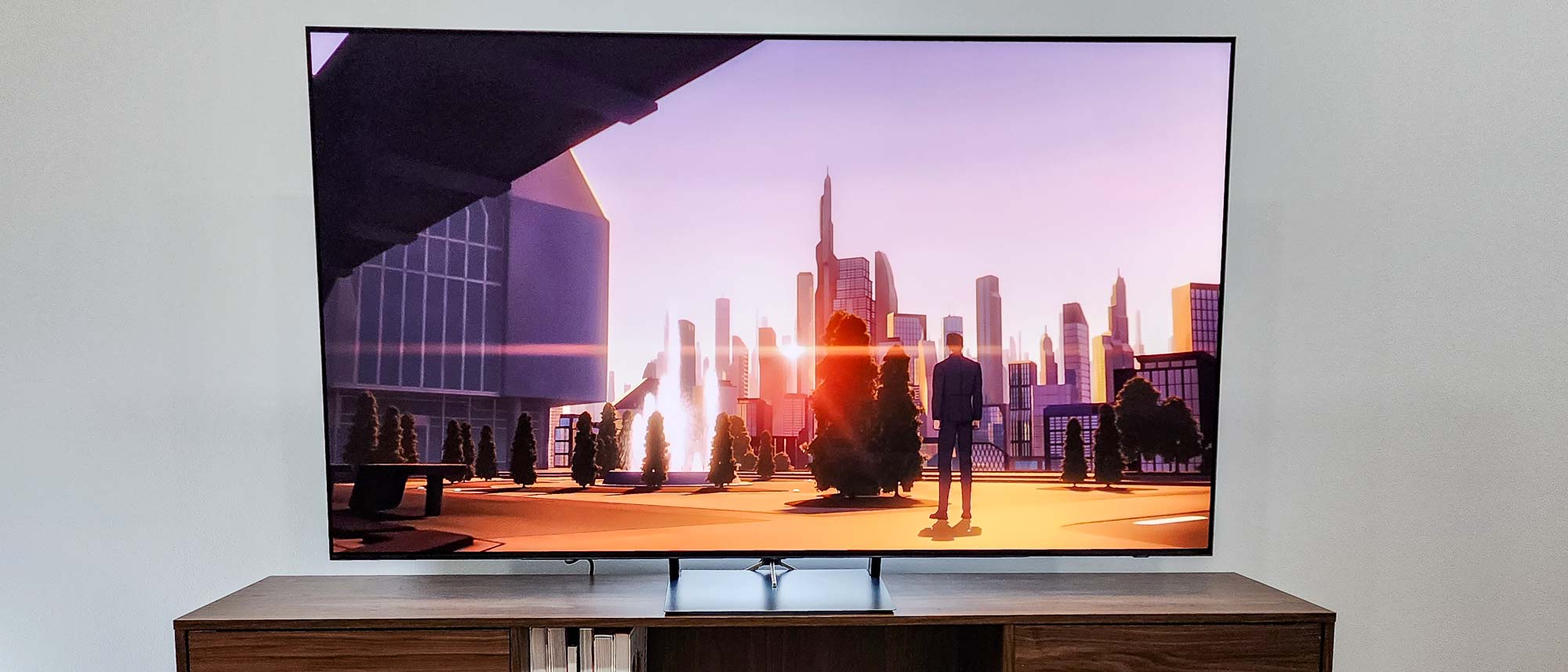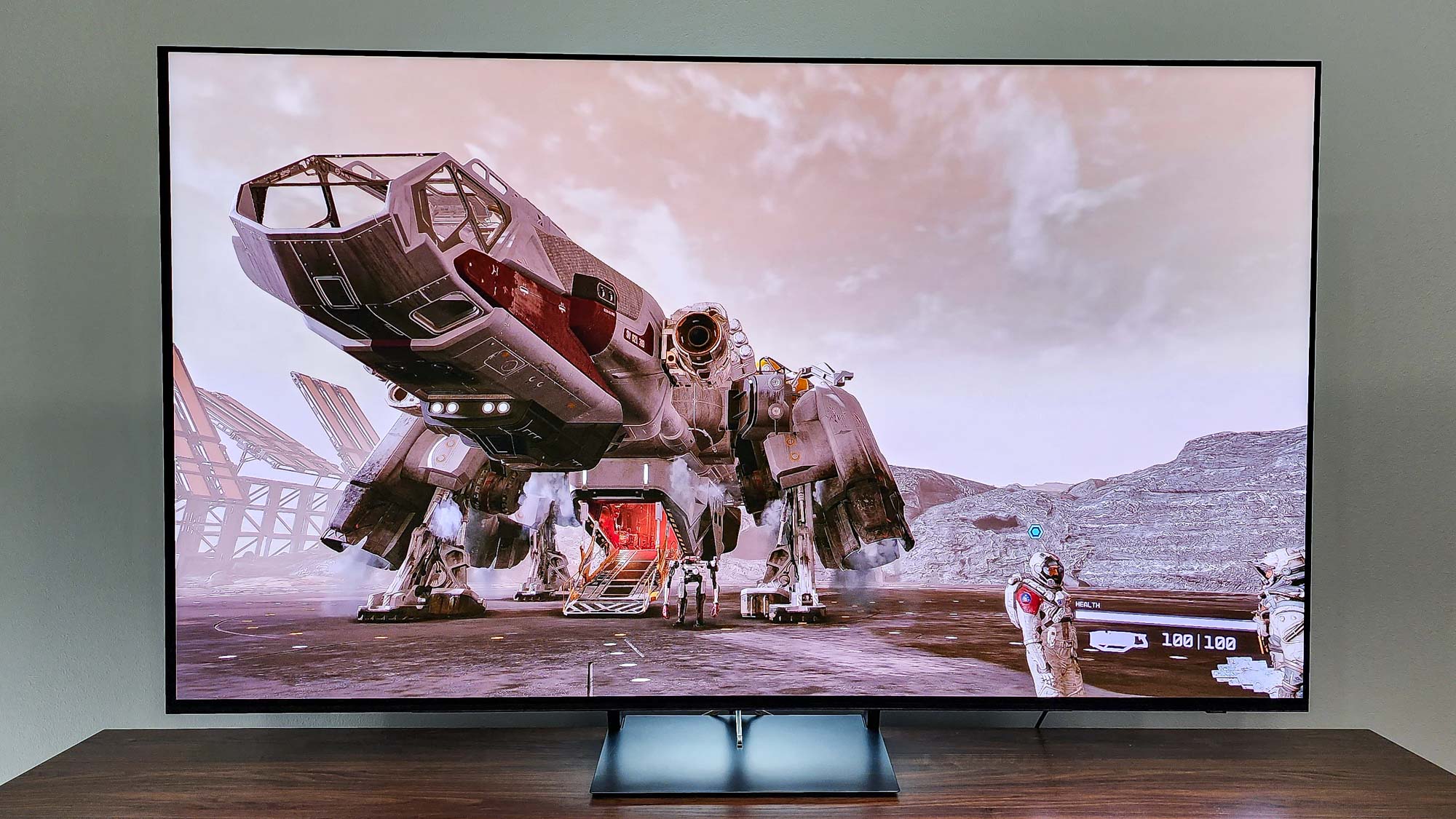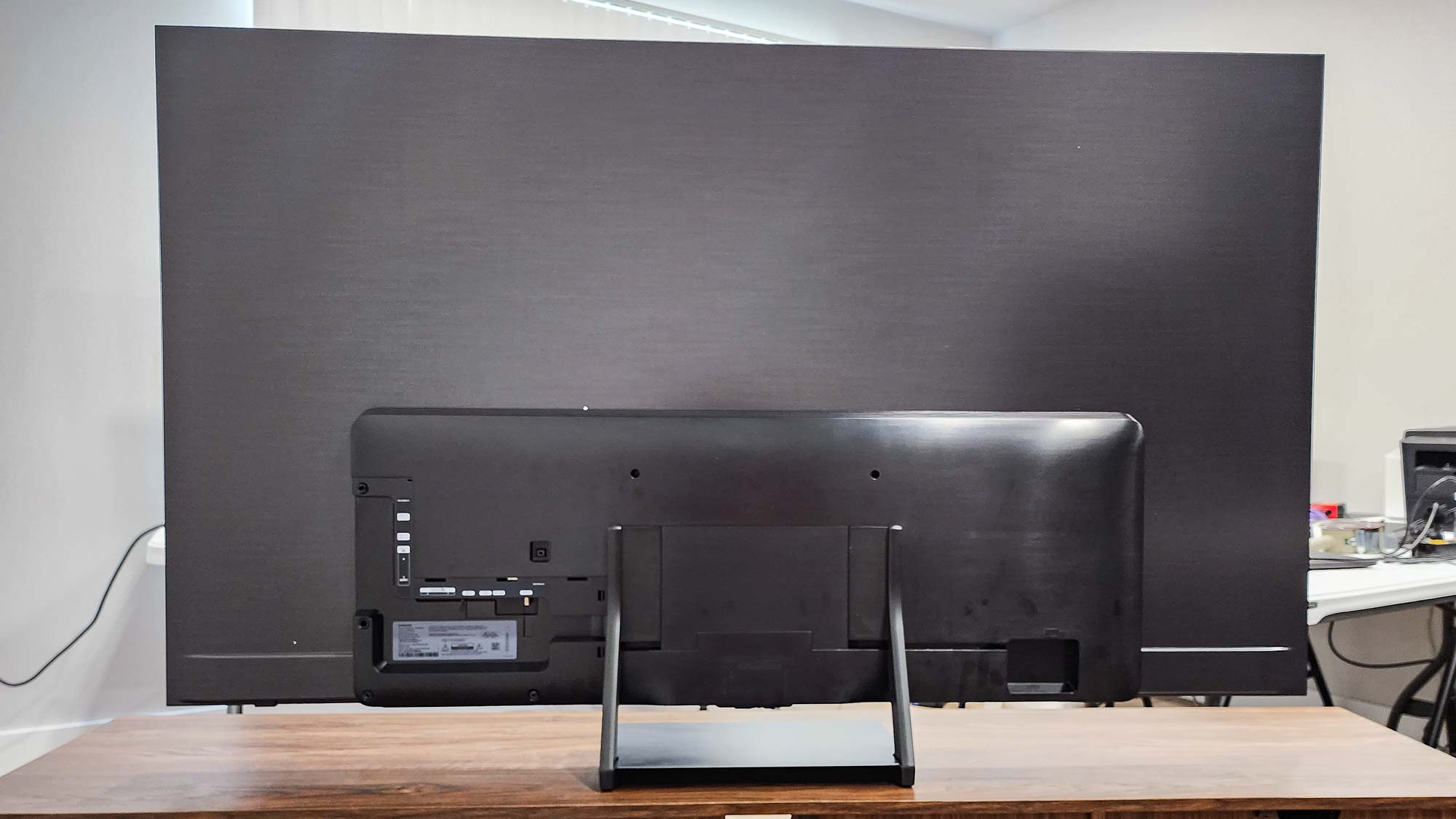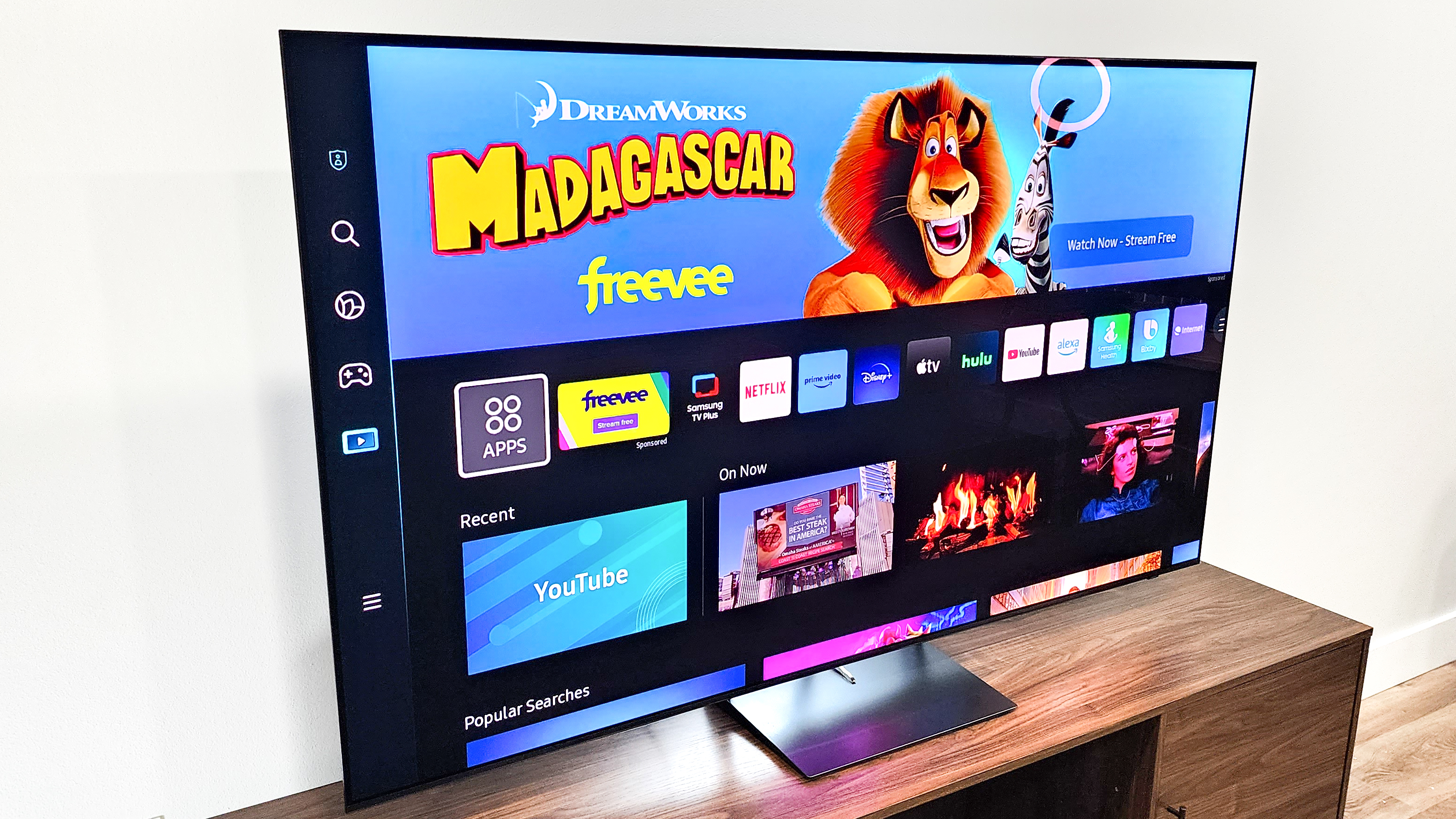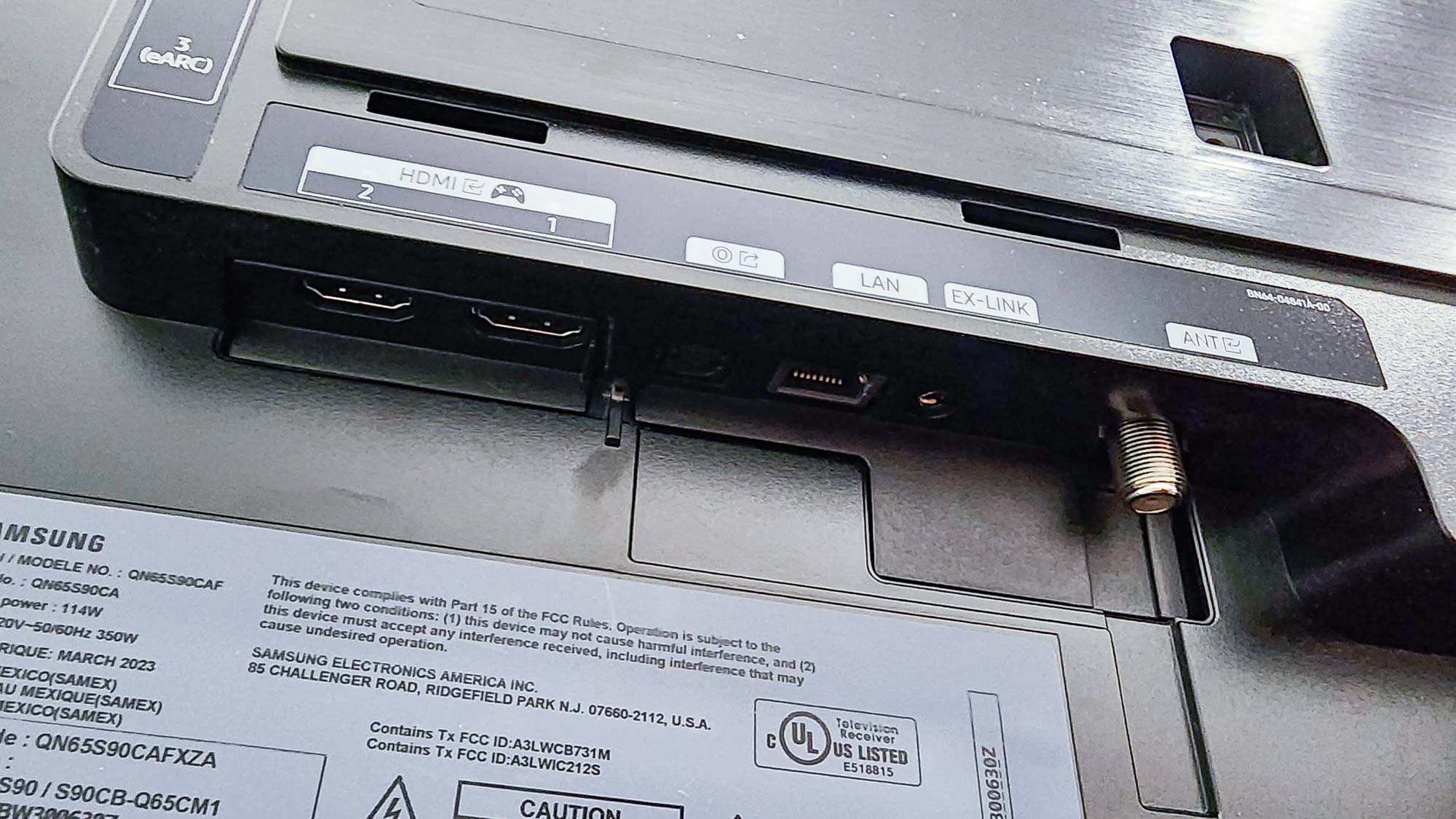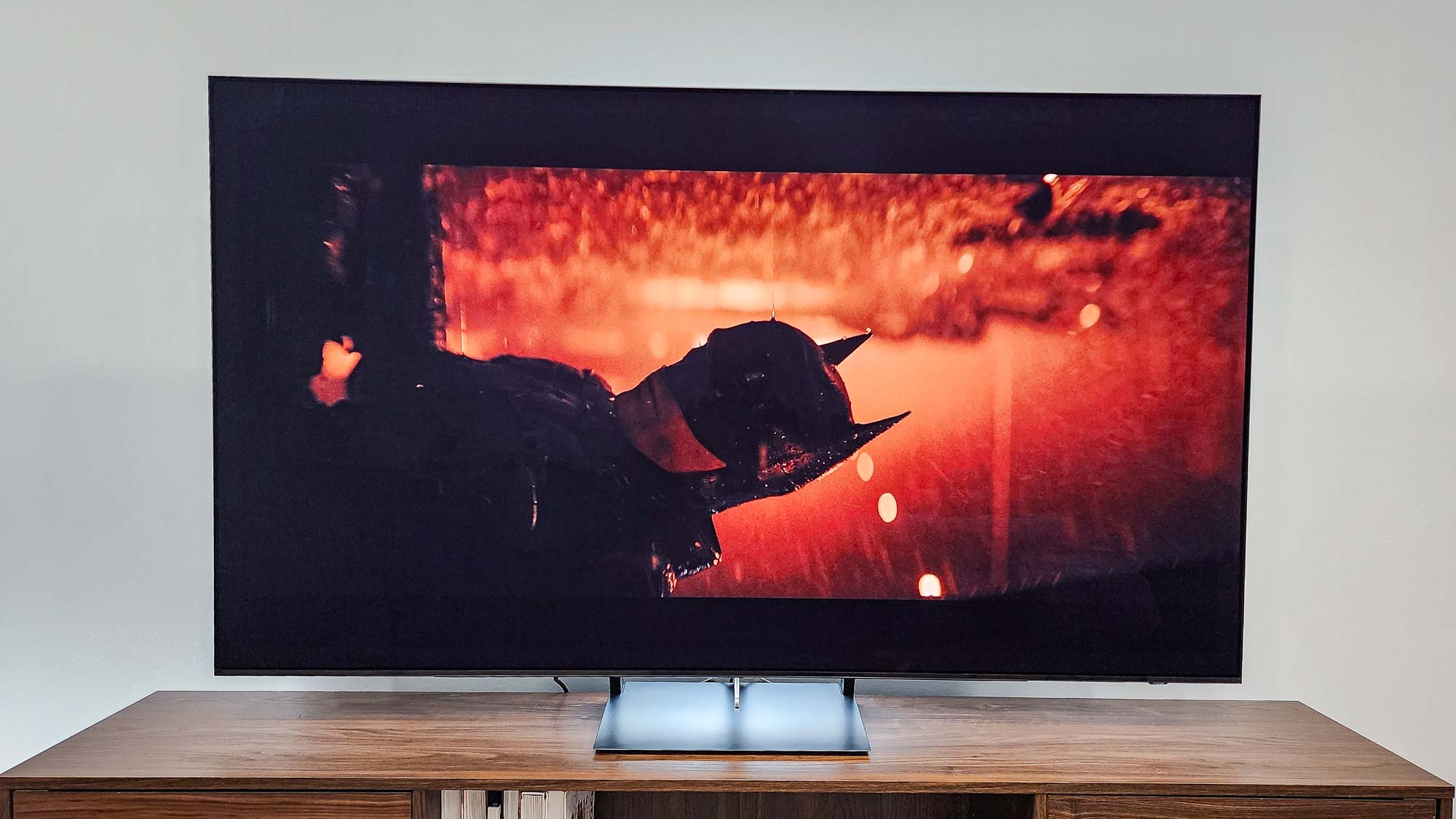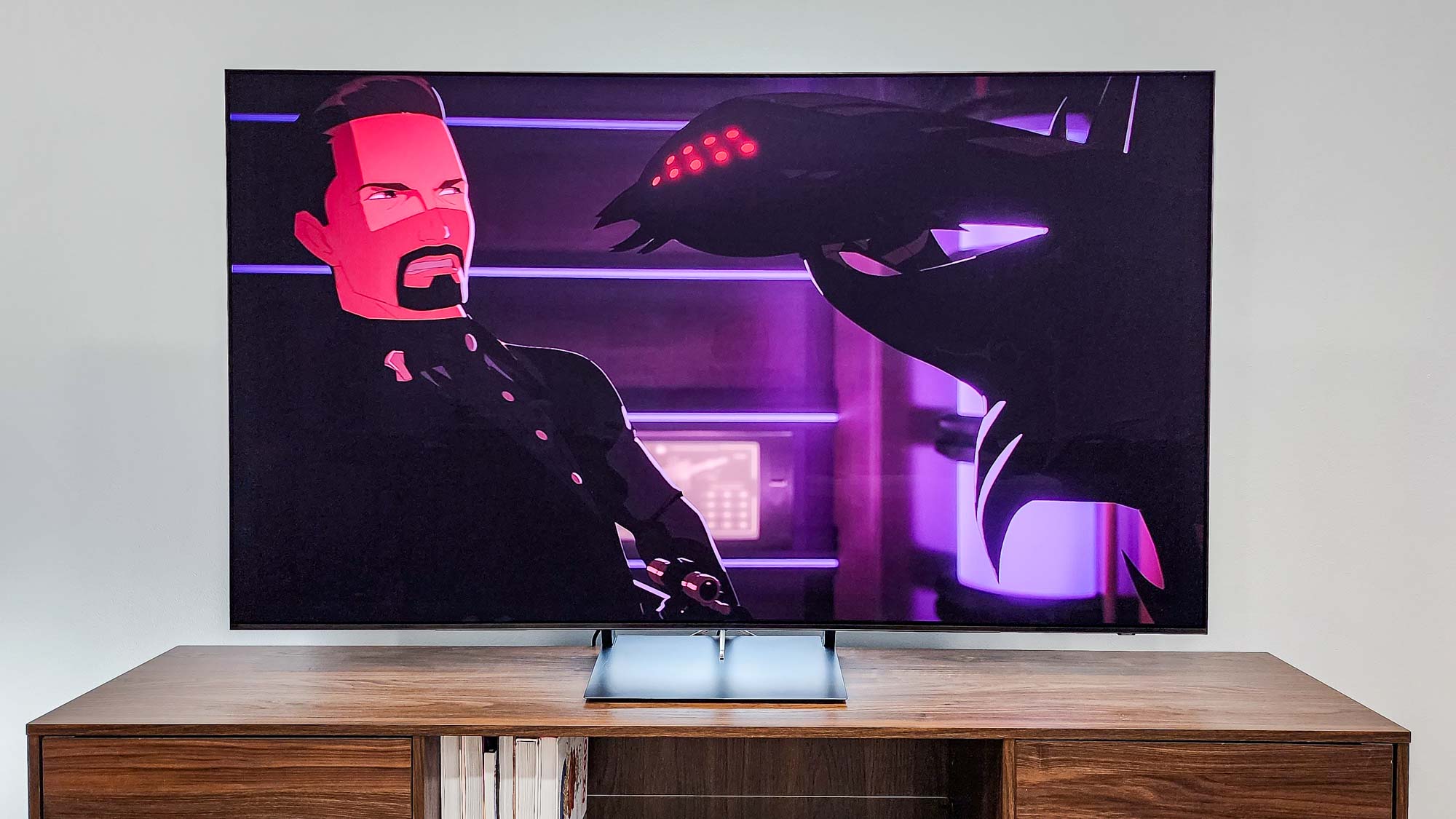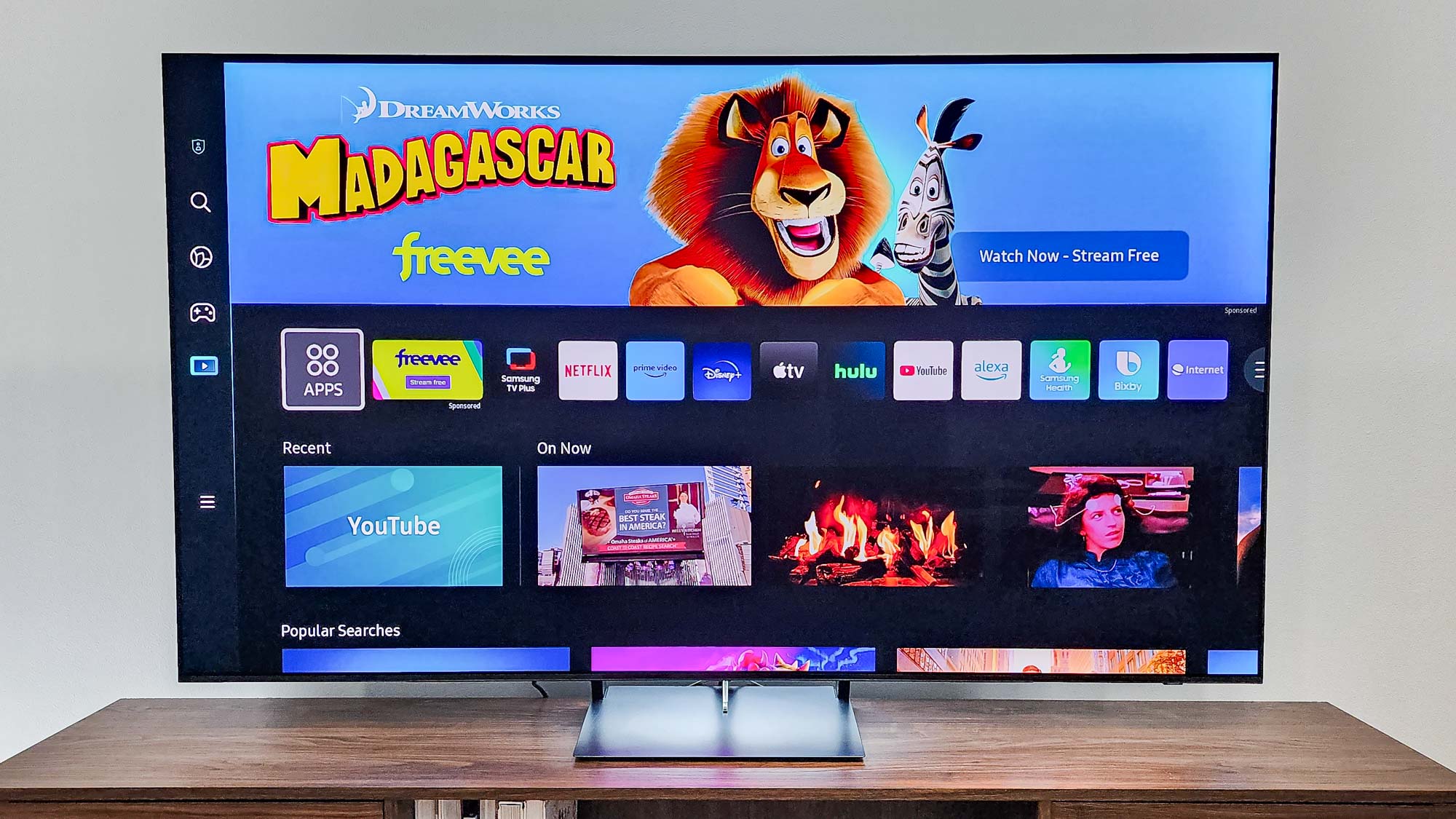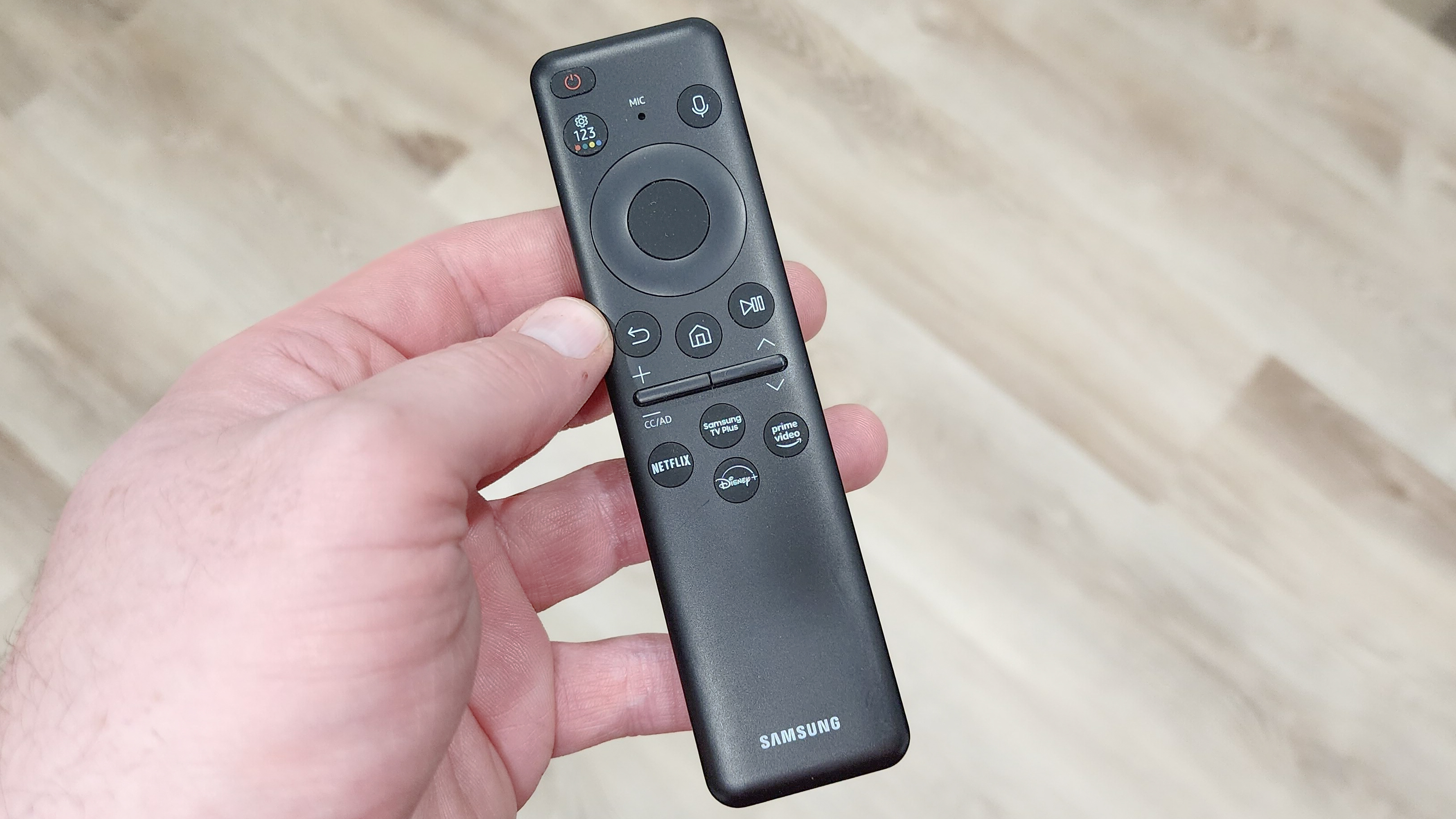Tom's Guide Verdict
Producing a killer picture and loaded with exciting features, the Samsung S90C performs well above its price, competing credibly with higher-end sets from all the major manufacturers. Though a few minor issues hold it back from perfection, it’s hard to find a better TV than this.
Pros
- +
Gorgeous picture quality
- +
Excellent gaming features
- +
Decent audio for a TV
- +
Equipped with ATSC 3.0 tuner
Cons
- -
Oversaturated HDR colors in Standard mode
- -
No Dolby Vision support
- -
Tizen is somewhat clunky
Why you can trust Tom's Guide
Price: $1,999.99
Screen Size: 65 inches
Model: QN65S90CAFXZA
Resolution: 3,840x2,160
HDR: HDR10, HDR10+, HLG
Refresh Rate: 144Hz
Ports: 4 HDMI 2.1, 2 USB
Audio: 40W
Smart TV Software: Tizen Smart TV
Size (without stand): 56.9x32.7x1.6 inches
Weight (without stand): 46.5 lbs.
The Samsung S90C, released in 2023, remains an excellent (and affordable) OLED TV in 2024. Though newer models like the Samsung S95D offer better brightness levels and more powerful processors, this midrange model makes the most of OLED tech at a price that isn't outright unreasonable.
What makes it so special? The combination of quantum dots and OLED panels has been a game-changer for TVs, with the rich, precise colors and searing brightness of the former an ideal marriage to the flawless blacks and near-infinite contrast of the latter. Though most manufacturers have explored this partnership, few have gone as far as Samsung — and even Samsung has never made as good a case for it as it has with the S90C.
This is an upper-midrange set that looks like it ought to be far more expensive than it is. It plays everything about as well as it could be played — provided you’re using the right picture mode (which we’ll get to) — and even manages above-average sound, which itself is no small feat. Its smart interface is still aging, yes, and the remote control edges a bit too much toward minimalism, but with a picture this good, it almost doesn’t matter.
Even taking into consideration its minor flaws, the Samsung S90C is unquestionably one of the best TVs you can buy — and undoubtedly the best you can buy in its price range.
Samsung OLED S90C review: News and updates
Samsung has taken the wraps off the Samsung S90C's successor, the new Samsung S90D OLED. The new penultimate OLED in Samsung's 2024 TV range won't have a glare-free screen like the S95D, but it does use the company's new Neural Quantum Processor 4K and a Dolby Atmos-certified speaker system. If you're thinking about buying the S90C, you might want to consider making the leap to the S90D instead.
Samsung OLED S90C review: Pricing and availability
The S90C is available in four screen sizes, with the listed and street pricing as outlined here:
- QN55S90CAFXZA (55-inch): $1,499.99
- QN65S90CAFXZA (65-inch): $1,999.99
- QN77S90CAFXZA (77-inch): $4,199.99
- QN83S90CAFXZA (83-inch): $4,799.99
Because the 55-, 65-, and 77-inch versions all use the same OLED panel technology, we expect performance among the three to be basically identical. The 83-inch model, however, uses a WOLED panel, so its picture quality will be different.
Get instant access to breaking news, the hottest reviews, great deals and helpful tips.
Samsung OLED S90C review: Design
OLED TVs seem to get thinner every year, and the S90C is well in keeping with that trend. It measures just 1.6 inches at its thickest point (the control box located at the bottom of the rear panel), and the screen itself measures just over one-eighth in depth — or just barely more than the width of the metal bezel that surrounds the screen on the top, left, and right. At 46.5 pounds, the TV isn’t heavy, but its dimensions (56.9 x 32.7 inches) will make it challenging for most people to safely move solo, so get some help if you can.
At the bottom of the screen, a wider bezel (about one-third inch) obscures the IR emitter and a hardware button in the center that gives you one-touch access to Power, Channel, Volume, and Source functions.
If you want to mount the S90C on the wall, you can use the included VESA holes (300x200 on the 55-inch and 65-inch sets or 400x300 on the 77- and 83-inch models). Or, for placement on an entertainment center or other flat surface, the included metal stand (with a squarish foot) slides on easily and elevates the set about 3 additional inches so you can slide a soundbar underneath the screen. Whichever way you choose, the S90C looks as stylish as it does svelte.
Samsung OLED S90C review: Ports
The power cable connects to a socket on the left rear of the TV and is positioned so the cable will drop down the center of the screen. (There’s a channel cut into the control box for routing the cable, but we had difficulty getting it to stay in there.) All the other ports are located on the right. Facing out from the TV’s edge are two HDMI and two USB ports. Additional ports are next to those, angled downward: two more HDMI, S/PDIF optical audio, LAN, Ex-Link, and the coaxial cable connector.
All four HDMI ports bear the newer 2.1 standard. This means any device you connect will support up to 4K resolution at a 120Hz refresh rate. Gamers get additional benefits in the form of Variable Refresh Rate (VRR) and Auto Low-Latency Mode (ALLM), as well as refresh rates up to 144Hz when the TV is hooked up to an appropriately outfitted PC.
Samsung OLED S90C review: Test results and performance
We always evaluate a TV in two ways: by playing a variety of different types of content, in order to see how it handles the kind of real-world stuff you’ll want to watch, and technical tests (with an X-Rite i1 Pro spectrophotometer, a SpectraCal VideoForge Pro pattern generator, and Calman calibration software) that dig even deeper into the set’s capabilities to discover what our eyes might miss.
In most of our objective tests in Filmmaker Mode (the closest you can get to out-of-the-box calibration) at the default settings, the S90C matched our (elevated) expectations. It delivered superb, category-leading brightness in both SDR and HDR modes (with only Samsung’s pricier S95C surpassing it), outstanding color reproduction (its Delta-E, which measures the difference in color between the source and what’s displayed on the screen, beat out all comparable sets), and HDR color gamut coverage ahead of all but the higher-end Sony A95K. The S90C’s SDR color gamut coverage is a shade lower than those of the LG C3 and the S95C, but just a shade.
| Row 0 - Cell 0 | Samsung S90C | LG OLED evo C3 | Samsung S95C | Sony A80L | Sony A95K |
| SDR Brightness (10%, in nits) | 257 | 237 | 249 | 224 | 297 |
| Delta-E (lower is better) | 1.3184 | 1.3908 | 1.4542 | 3.3797 | 3.3223 |
| Rec. 709 Gamut Coverage | 98.6903 | 99.0904 | 98.7273 | 109.529 | 110.8434 |
| HDR Brightness (10%, in nits) | 1073 | 820 | 1369 | 676 | 994 |
| UHDA-P3 Gamut Coverage | 99.76 | 98.98 | 99.09 | 99.08 | 99.95 |
| Rec. 2020 Gamut Coverage | 74.94 | 73.77 | 74.47 | 73.27 | 89.44 |
| Input Lag (ms) | 9.2 | 12.9/9.1 | 9.2 | 16.3 | 16.1 |
Watching the S90C was a true joy in Filmmaker Mode, too, whether we were playing a modern action movie like Top Gun: Maverick, a more cerebral sci-fi flick like Denis Villeneuve’s Dune, animated fare like The Super Mario Bros. Movie or Babylon 5: The Road Home, a “fusion” title such as Avatar: The Way of Water, or the gritty neo-noir superhero film The Batman. If not for the TV’s lack of Dolby Vision support, it would be all but ideal for watching anything.
Problems only crept in when we switched over to the usually safe, if unexciting, alternative: Standard mode. Though most fully live-action movies continued to look okay, Avatar: The Way of Water lost some of the sumptuous nuances of the greens and blues that constitute so much of its color palette and looked slightly sickly and flat.
The Super Mario Bros. Movie, which is essentially a celebration of color, became a touch overbearing in appearance. And Babylon 5: The Road Home lacked a bit of the well-defined punch its classic-meets-cutting-edge animation can pack at its best.
Our test results showed that Standard was the least accurate and well-balanced mode on the S90C when it came to HDR, even when compared against Dynamic, which is very rare. In one way, it was even unique: In Standard mode, the S90C became the first TV we’ve ever tested that overshot 100% coverage on the UHDA-P3 color gamut (which differs from DCI-P3 by a marginally different red primary). This oversaturation would explain why the color-heavy HDR content didn’t quite look right. (For comparison purposes, the results were 108.03% for Standard mode and 98.06% for Dynamic.)
Again: This affects the S90C only in Standard mode with all the settings at their defaults, and things look so terrific in Filmmaker Mode (and to a lesser degree elsewhere) that, provided you manage the modes carefully, you could well never notice a problem. But because Standard is generally intended to work decently with everything, it’s odd to find a TV where that isn’t quite true.
Samsung OLED S90C review: Audio
Sound on the S90C is in no way remarkable, but it’s also in no way bad. Its 40-watt, 2.1 channel system supports Dolby Atmos and Object Tracking Sound Lite, the latter of which strives to make what you’re hearing sound like it’s coming from what you’re watching.
I was not blown away by the latter feature, but that’s par for this particular course. The S90C isn’t quiet, but it also never gets too loud (we generally needed to crank it up past 25 for general listening). It doesn’t have the kind of chest-rattling bass you may hope for, but it was totally fine playing The Knife’s “Silent Shout,” imbuing its opening sequence with enough thump to pass muster. When playing higher music, such as a soprano test track that crests to a high B-flat, it emitted an acceptable level of warmth without any discernible distortion, even at top volume levels. Heavily layered film soundtracks similarly unfolded without either issue or unanticipated excitement.
If the audio doesn’t reach the level of Sony’s A95K or A80L, it’s a notch or two above what we get from most TVs (including the LG C3 and G3), and thus an easily defensible choice for non-snob listening in a home environment. And if sound is important enough to you that that isn’t good enough, check out our roundup of the best sound bars.
Samsung OLED S90C review: Gaming
Like almost all of Samsung’s recent sets, the S90C boasts impressively low input lag. Using a Leo Bodnar 4K Lag Tester, we measured a mere 9.2ms, firmly beneath our 10ms threshold for a great gaming experience and among the very lowest we’ve encountered. (LG’s newer sets, when boosted, perform similarly, but Sony doesn’t do quite as well.) And, as previously mentioned, HDMI 2.1 allowing for VRR, ALLM, and up to 144Hz rates give you just about everything you would need from a gaming TV.
Though Samsung’s Gaming Hub, which collects all your consoles and games in progress in one place, can add an extra layer of complication to firing up whatever you want to play, the pop-up gaming bar can come in handy. By holding down the Play key (see the Remote section for more), you can bring it up to make on-the-fly changes to a number of gaming-related settings including the Game Picture Mode, Input Lag, Game Motion Plus (a form of motion smoothing), and Sound Output, as well as adjust play aids such as Minimap Zoom and Virtual Aim Point. The bar is relatively compact and anchored to the bottom of the screen, so it’s never in the way.
Unsurprisingly, looking at and playing games on the S90C is fantastic, too. The mysterious worlds, colorful personalities, and exotic alien creatures of Bethesda Softworks’s eagerly awaited Starfield jolt to life on the screen, propelling you into the center of what feels like the most expansive sci-fi series ever. Everything from planet surveying to intense space combat smokes with color and crisp clarity.
Samsung OLED S90C review: Smart features
The S90C ties into the Samsung SmartThings ecosystem, allowing you to control it (and your other devices) via a mobile app as part of your larger smart home strategy, and Samsung’s Bixby and Amazon’s Alexa voice assistants work with it as well. But the TV’s on-screen smart interface leaves something to be desired. Tizen is sparse and no-nonsense in terms of its overall design, but it can be a bit unwieldy to navigate.
Below a large banner at the top of the screen is the Apps bar, which during our test period we noticed could be populated with sponsored items (in our case, links to Fortnite and Twitch) — not a development we love. Then are the “Recent” and “On Now” sections, which surface other things you’ve been watching or may want to watch, followed by “Popular Searches,” “Continue Watching,” and a large number of other curated categories you may not care about.
Moving around this home screen (which Samsung calls Media) isn’t too bad, but select Search, Ambient, or Game from the main menu on the left and you’ll be taken to entirely separate screens to browse. Those categories are all as well designed as Media, but it’s still clunky and inconvenient.
Samsung TV Plus is Samsung’s proprietary live streaming app, and like the equivalent offerings from LG and Sony is on the anemic side. It provides a wealth of shows, sure, but most of them are unexceptional, and it can all be cumbersome to navigate, especially compared with other services such as Google TV. The S90C’s integrated ATSC 3.0 tuner will let you play 4K over-the-air broadcasts, so there’s always another way to pick up live programming. AirPlay 2 also lets you stream from your Apple device.
Samsung OLED S90C review: Remote
Although just about every major TV company has shrunk its remote over the last few years, no company has gone quite as far as Samsung. Its newest remote is about the size of a candy bar, though not as thick, measuring only 5.6x1.5 inches. And as the black plastic unit has only 14 buttons, including the Microphone (for searching or otherwise interacting with the S90 by voice), five-way direction control, the Channel and Volume rockers, and four shortcut keys (for opening Samsung TV Plus, Netflix, Prime Video, and Disney+).
This has its pluses and its minuses. It will fit comfortably in every hand, but it’s much easier to lose. The buttons are easy to operate, but they’re not backlit, so you may have some trouble in a darkened room. And as nice as the ultraclean layout looks, it might be too Spartan. It takes a few extra presses to access the settings (via the same button as Numbers and Colors), and you will need to consult the documentation to figure out how to mute the sound, bring up the game bar, and so on.
One unalloyed convenience of the remote is that you’ll never need to worry about changing batteries. It’s powered by a miniature solar panel on the bottom, so just leaving it on a sunny windowsill or even under a bright overhead light for a few hours will recharge it (though the former is the faster way to go). This makes up for much of the remote’s other fussiness and is an idea we’d love to see other TV manufacturers adopt.
Samsung OLED S90C review: Verdict
It wasn’t that long ago that OLEDs TVs were rare, mystical, and outlandishly expensive — getting the best picture on the market invariably meant paying handsomely for it. But those days are now long gone, consumers have benefited, and, with the newer sets out there, the middle range of the market is where all the action is at — and Samsung stakes a powerful claim to winning that war thanks to the S90C.
Its enhanced brightness and generally deft color handling (well, outside of Standard mode) craft a picture that’s almost as good as you’ll see from sets that cost $1,000 more, and its other features, including an ATSC 3.0 tuner and tons of gamer-optimized functionality, only further seal the deal. That there are a couple of weak areas almost doesn’t matter when everything else is so good — you can grin and bear your way through the limited Tizen interface and put up with an undercooked remote control. As soon as you turn on your favorite show or game — all will instantly be forgiven. There’s not much more you could ask for from a TV.
Matthew Murray is the head of testing for Future, coordinating and conducting product testing at Tom’s Guide and other Future publications. He has previously covered technology and performance arts for multiple publications, edited numerous books, and worked as a theatre critic for more than 16 years.
